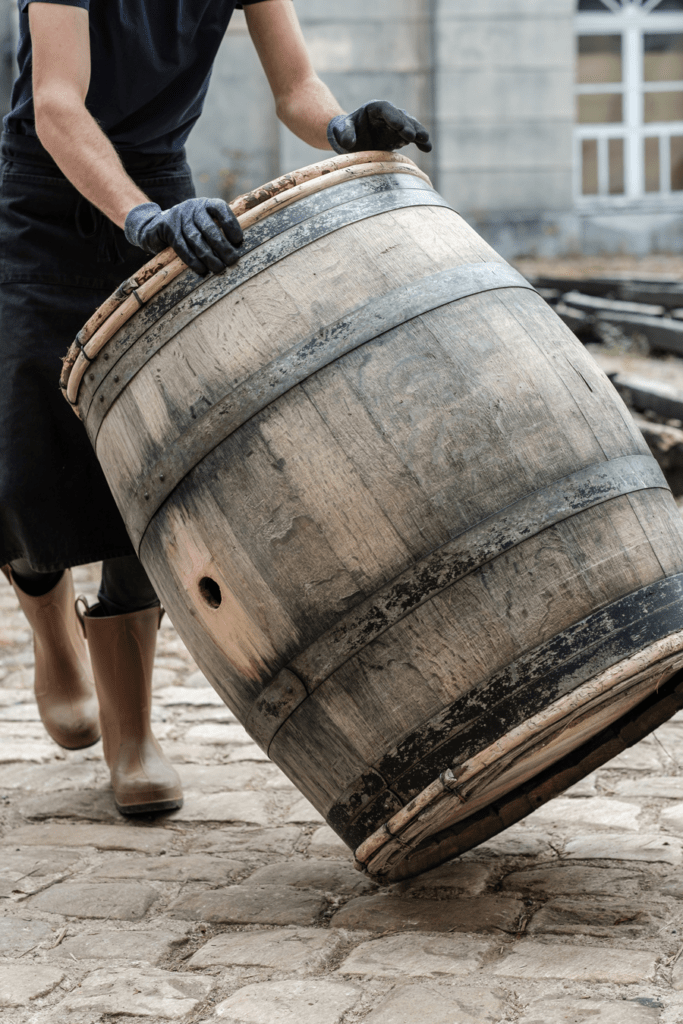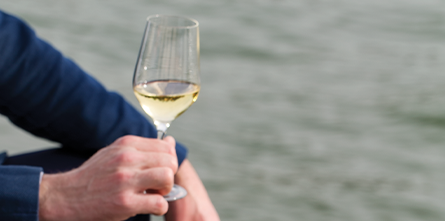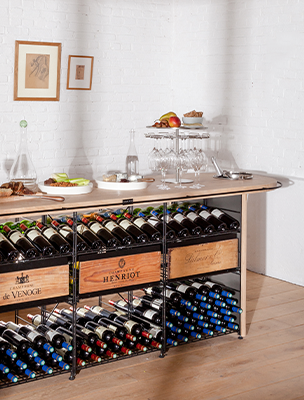
© Alexandre Couvreux
Wine is a mysterious language. It would take a lifetime to discover all the subtle tastes, smells and secrets of wines around the world. The region, climate, grape varieties, vinification, ageing… All these factors determine the unique expression of wine aromas.
Cherry, honeysuckle, toast, chocolate… What is an aroma in oenology? Can you improve your perception? How can you describe a grand cru’s aromatic signature? What is the difference between a wine’s aromas, perfumes, notes and bouquet?

© Alexandre Couvreux
Here is a complete guide to wine aromas and olfactory perception, to introduce you to the science of oenology. L’Atelier du Vin has been designing and manufacturing fine wine-tasting tools from father to son since 1926, to preserve and release aromas from the wine cellar to the tasting table.
Contents:
- Aromas in oenology
- How to recognise wine aromas
- Which oenology accessories should you use to preserve and release a wine’s aromas?
Aromas in Oenology
When you open a beautiful bottle and embark on an oenological wine-tasting experience, the wine tells a story and creates emotions that words alone cannot express.
Aromas, not letters or words, convey a message in this age-old language of nature. Each combination of aromas is unique and reveals the wine’s spirit.

Wine aromas, through their subtlety and diversity, have always fascinated winemakers, oenologists, sommeliers and cellarmen, and delighted neophytes and wine lovers’ senses. Here is an introduction to the science of oenology to help you recognise, classify and understand the aromas of wine.
A Definition of Aromas in Wine
An aroma is a pleasant smell. In wine, aromas are the smells that arise in the nose and mouth. Their perception is olfactory (through the olfactory cilia in the nasal cavity), and not gustatory. A wine’s bouquet describes the combination of aromas, whereas the notes are minor or barely perceptible aromas.

More precisely, an aroma can be differentiated from an odour because it is perceived by both the mouth (connected to the nasal cavity) and the nose. Aromas also shouldn’t be confused with flavours, which are associated with taste (perceived by the tongue’s taste buds) and can be described as sweet, salty, sour, bitter, astringent or unami.
Aromas are volatile and infinitely varied. Consciously exploring them requires focus and concentration, like analysing a perfume to identify its components.
Recognising aromas will not only enhance your tasting pleasure, but also help you assess the wine’s origin and age. To interpret and analyse this information, you need to distinguish between three types of aromas, as well as different aroma families.
The 3 Types of Aromas in Wine
In oenology, there are 3 categories of aromas.
- Primary aromas, i.e., the grape variety aromas. Each variety has its own unique aromas and subtleties linked to the soil and climate.
- Secondary aromas are derived from the winemaking process and yeast used for fermentation (transformation of grape’s natural sugar into alcohol).
- Tertiary aromas arise during the ageing process, particularly when the wine is aged in wooden barrels, in a wine cellar (also called the bouquet)

© Alexandre Couvreux
An expert winetaster, with heightened olfactory senses, can recognise each type of aroma and identify the grape variety or varieties used in the wine, the vineyard, the winemaking process, the aging process and the age.
A Glossary of Wine Aroma Families
Beyond these 3 categories, each aroma can be grouped into aroma families. This classification is inspired by nature, and the specific smell of different plants, animals or minerals. Here is a list of wine aroma families.
- Floral aromas: rose, violet, honeysuckle, honey, linden, verbena, beeswax, orange flower, etc.
- Fruit aromas: cassis, blackberry, blueberry, raspberry, strawberry, apricot, peach, grapefruit, banana, lychee, lemon, apple, quince, prune, fig, mango, papaya, hazelnut, almond, walnut, etc. There are several sub-categories in this family, such as fresh fruit and citrus, red and black fruit, dried fruit or candied fruit.

- Vegetable aromas: pine, truffle, hay, tobacco, grass, mushroom, pepper, box-leaf, green wood, damp wood, pencil, etc.
- Animal aromas: leather, amber, cat urine, musk, damp fur, dry meat, game, etc.
- Mineral aromas: quartz, flint, chalk, etc.
- Burnt aromas (reminiscent of smoke, burning or cooking): pastry, toast, caramel, tea, coffee, chocolate, gun-smoke, etc.

- Herbs and spices: pepper, thyme, cinnamon, rosemary, basil, bay leaves, etc.
- Other aromatic notes: liquorice, vanilla, mint, butter, milk, etc.
- Odours indicating a defect or deterioration: cork, mould, detergent, rotten egg, rubber, sulphur, vinegar, etc.
Now that the main aroma families have been defined, let’s explore a more detailed glossary of each of the 3 types of aromas.
Glossary of Primary Aromas by Grape Variety
Each terroir, vineyard or wine region grows a specific grape variety. Here is a brief glossary of grape variety aromas, or primary aromas.
Examples of red grape varieties:
- Pinot Noir: cherry, cassis, violet, truffle
- Cabernet(s): pepper, truffle, raspberry
- Merlot: pepper, truffle, leather, violet
- Syrah: liquorice, pepper, leather, violet
- Mourvèdre: pepper, liquorice, pine
- Gamay: cassis, raspberry, violet
- Grenache noir: cherry, raspberry, blackberry, cassis
Examples of white grape aromas:
- Muscadet: honeysuckle, rose
- Chardonnay: peach, honey, pastry, amber
- Sauvignon: basil, peppers, honey
- Riesling: grapefruit, honey, lychee
- Gewurztraminer: honey, lychee, pepper
- Chenin: hazelnut, honeysuckle

Glossary of Secondary and Tertiary Aromas
As explained previously, secondary aromas are linked to the winemaking process, whereas tertiary aromas provide information about a wine’s ageing process. Here is some of the key information you can derive from typical secondary and tertiary aromas.
- Vanilla: aged in new oak barrels
- Tobacco: red wine that has been cellared for several years
- Tea: white wine that has been cellared for several years
- Lemon: ripe or over-ripe grapes at harvest
- Mushroom: some red wines after a few years cellaring
- Chocolate or strawberry: a red wine at its best
- Quince: a white wine at its best
- Fig: very ripe grapes

How to Recognise Wine Aromas
To fully appreciate a red or white wine, you need to call on your 5 senses. How does your perception of aromas work? How can you describe a wine based on what your nose and mouth perceives? What are the best conditions to taste a fine wine in? Let’s take a closer look at the perception of wine aromas.
How Are Aromas Perceived?
The olfaction process enables you to perceive aromas. Odours and flavours are perceived by olfaction and retro-nasal olfaction, through the receptors in your nasal cavity. What does this mean?
- Olfaction is the act of sniffing or inhaling. Volatile molecules travel up the nasal passage.
- Retro-nasal olfaction takes place when the molecules reach the olfactory bulb from the back of the mouth cavity.

We have 50 to 100 million olfactory cilia, sensory cells that cover about 5cm² at the top and back of our nasal passage. In big dogs, for example, these cells can cover up to 200cm², which is why dogs have such a good sense of smell compared to humans!
These cells capture molecules and transmit olfactory information to the brain. This information transits via electrical micro-currents. Our hypothalamus then determines if the odour is pleasant or not.
According to certain scientific studies, women are more sensitive to aromas than men. This could be explained by physiological and cultural reasons. In certain traditions, women are introduced to the art of perceiving scents, aromas and perfumes at an early age.
How to Taste Wine to Perceive its Aromas
For ensure that all a wine’s aromas are released, you need to follow each stage of the oenological process. Which is why wine tools are so important, from preserving bottles in a cellar, to preparing, opening, serving and storing them. Aromas are volatile, so decanting and aerating a wine, according to its fragility and age, is particularly important.
The next step is to serve the wine in an appropriate wine-tasting glass, such as our Exploreur Oenologie, which is a favourite among wine experts and sommeliers. Use an aerator pourer if necessary to gently serve the wine, until the glass is a quarter or one third full. Then:

- During the first nose, smell the wine without swirling it to perceive the most volatile and subtle aromas.
- During the second nose, swirl the wine (unless it is too old and fragile) to fully release the aromas.
- Then, taste the wine by sipping and oxygenating it your mouth, to optimise the retro-nasal olfaction process from the palate to the nasal cavity. This will enable you to appreciate the harmony between the flavours and aromas.
After drinking (or spitting out) the wine, the “caudalies” indicate (in seconds) how long the wine’s aromas persist in your mouth. Once the intensity of the main aromas has declined, minor aromas may arise.
Top tip: if you feel like your olfactory capacity is saturated, try sniffing the inside of your elbow. Smelling your own skin helps to neutralise strong smells and “clean” your nose.
A Glossary for Analysing a Wine’s Aromas
If you follow all the steps above, your perception of a wine’s aromas will be optimal. Now, it’s time to put your impressions into words. When tasting wine, connoisseurs use various words to describe it. Here is a glossary of aromatic terms to qualify wine.
- Ample: wine with aromas from different families.
- Aromatic: wine whose dominant aromas are aromatic herbs (basil, fresh mint, thyme, etc.).
- Woody: wine with a slightly vanilla and toasty smell, due to ageing in wooden barrels, usually made out of oak.
- Complex: wine whose bouquet evolves in the glass and has a rich and wide range of aromas.
- Generous: wine full of aromas and flavours, which seems warm and expansive.
- Flat: wine that has lost the sharpness of its aromas, usually as a result of prolonged contact with air.
- Faded: wine that has lost its freshness and is past its best.
- Closed: wine – often young – with timid and not very distinct aromas.
- Floral: wine with markedly floral aromas (rose, violet, honeysuckle, etc.).
- Foxy: wine with animal smells: amber, leather, etc.
- Expressive: wine with precise and recognisable aromas.
- Fruity: wine with strong fruit or grape aromas.
- Smoky: wine with smoked food odours (e.g.: certain Sauvignon wines).
- Gamey: wine that smells like game (odd but sought-after)
- Linear: wine whose aromas all belong to the same family.
- Mineral: wine with notes of flint, damp stone, pencil lead or powder.
- Open: a wine whose bouquet has been released through oxygenation.
- Perfume: a rich and pleasant odour.
- Roasted: sweet wine with candied fruit or toast aromas.
- Flattering: wine that is very agreeable to the nose but delivers short of the mark in the mouth.
- Truffle: a powerful aroma, characteristic of the best white and red wines.
- Vegetal: wine with strong greenish aromas (pine, truffle, hay, mushrooms, etc.).
How to Develop Your Aroma Memory and Olfactory Skills
An olfactory analysis requires intense concentration. Closing your eyes will help you gather your knowledge and, above all, your olfactory memories. A wine may well remind you of your grandmother’s jam or your honeymoon on the beach.
Use your olfactory and sensory memory to define each aroma!

Not everyone shares the same taste and smell perceptions. Whereas there is such a thing as a “standard” visual image, there is no such thing as a taste or smell benchmark. Which is why “wine-aroma” associations should be seen as memory joggers, rather than hard and fast rules.
People are often also short of words to describe perceptible scents. In most Western cultures, for example, parents teach their children to look, listen, taste and touch, but rarely to smell! Yet odours have an almost magical influence on our lives. They bring us closer to nature. And what could be more evocative than the smell of linden blossom in the playground, earth after a summer rainfall or freshly mown grass?

The way we experience smells has a lot to do with our memory. Yet, it is often difficult to remember a smell. According to Vladimir Nobokov, “memory can bring back almost everything except odours, and yet nothing evokes the past as intensely as an odour that is associated with a particular event.”
There’s no secret to improving your perception of wine aromas… Train your olfactory memory: relearn all the good and bad smells from nature and everyday life! The olfactory memory works like the visual, sound or mental memory. It needs to be exercised and enriched to be effective. If you practice regularly, your collection of identifiable aromas will grow and grow, making you better at distinguishing them.
Which is why we recommend always having aromas to hand: identifying and naming odours, as well as widening your aroma palette, will improve your ability to taste wine. And enhance your pleasure!

Enrico Bernardo, the World’s Best Sommelier in 2004, at the age of 26, shared his secret: “I have been smelling since I was a child. A major part of my preparation for the world’s best sommelier competition was to sit down in front of thirty different spices, fifteen different sorts of sliced fruit, or a bunch of different flowers. I recommend similar exercises to all wine-lovers who want to make rapid progress.”
What Are the Best Wine-tasting Conditions to Appreciate Aromas?
Use the following simple and effective tips to turn your wine-tasting sessions into extraordinary oenological experiences.
- When? The best moment for tasting wine is shortly before mealtimes, around 11am or 6pm, when your senses are wide awake.
- Where? Anywhere you feel comfortable (living room, garden, wine cellar, etc.). Simply avoid any parasitic odours (flowers, smoke, cooking, etc.), and make sure the lighting is good.
- With whom? The best tasting companions are your friends, of course! Share your tastes and sensations and find out more about each other.
- With what? You could serve some bread, and maybe some ham and cheese (with neutral tastes). Make sure you have some glasses of water ready too, so that your guests can rinse their palate between wines. And finally, a champagne bucket or spittoon.
- At what temperature? A low temperature will diminish the wine’s aromas. Whereas wine at the right temperature will have an optimal aromatic expression.
Which Oenology Accessories Should You Use to Preserve and Release a Wine’s Aromas?
Wine aromas are precious and subtle. Which is why, for centuries, winegrowers and sommeliers have been passing on their knowledge, processes, techniques and wine tools, to deliver the best possible wine from the cellar to the table. Here are some essential wine accessories to appreciate the aromas and flavours of wine.
The Exploreur Oenology, a Wine Glass that Reveals Aromas

The Exploreur Oenology is blown from high quality lead-free glass. The “Aroma Line” on the bowl is a technical feat that took several years of research and work to perfect. No two lines are the same, which is why each Exploreur Oenology wine glass is unique.
The Aroma Line takes a wine’s aromas to the next level. The most prevalent aromas become more powerful and defined, while new, more subtle and complex aromas are also released. The shape of the Exploreur Oenology’s bowl also lets the wine breathe more intensely and preserve its aromas, which makes this gem of glasswork an essential oenological tool.

For an optimal olfactory perception, pour the wine into your Exploreur Oenology glass, filling no more than one third.
- Before swirling the wine in your Exploreur Oenology, smell it. This is known as the “first nose”. You will perceive the most volatile aromas. Only 5% of odorous molecules reach your nasal cavity.
- Then, swirl the wine for a few seconds in your Exploreur Oenology glass, and smell the difference. This is the “second nose”. The movement of the wine against the wall of the glass significantly increases the intensity of the aromas.
Remember to adapt your movements to the age of the wine. Swirl young wines freely in the glass. But pour an old wine slowly and gently, and smell without swirling, since its molecules are more fragile and volatile.
See also our Exploreur Spirits glasses, to taste and reveal the aromas of your favourite liqueurs, hard liquor and spirits.
Corkscrews
This might seem trivial, but people often forget how important it is to use a reliable corkscrew, that is suited to the type of bottle you want to open. After all, a broken or crumbled cork would ruin the wine’s aromas. Our collection of bottle openers, design in France, were designed to ensure the safe extraction of any cork and enjoy the art of living wine.
Aerator Pourers
Some winemakers say that bottles imprison the wine. So, when you open a bottle, you have to help the wine feel free again! An aerator pourer is useful for precise pouring (to not lose a drop), and also to help the wine breathe and regain its senses.
Decanters
If there is some deposit at the bottom of your bottle or your wine needs to be aerated for a few hours after opening, a decanter will help it reach its full potential. Our elegant wine decanters will enhance your tasting experience.

Vacuum Pumps and Wine Stoppers
Leftover wine? Would you like to enjoy it tomorrow or the day after? Then a vacuum pump and wine stopper are essential items in your wine toolbox. An electric vacuum pump, prestigious stoppers… discover our collection of wine preservation accessories.
Did you find this guide to wine aromas useful? Discover our other guides and tips to help you learn about wine and cultivate your art of living with wine.








